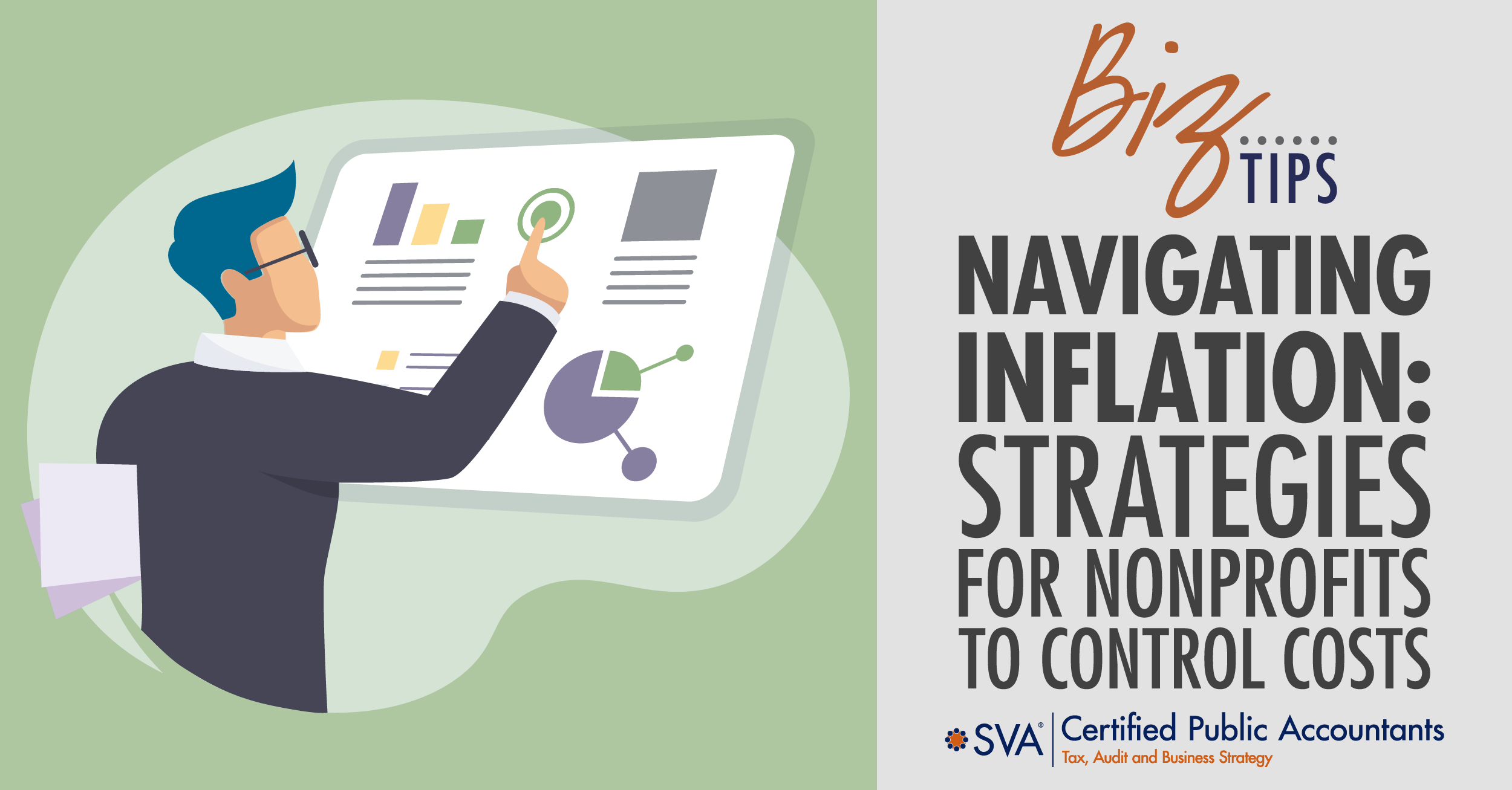| Highlights: |
- Explains key inflation impacts on nonprofit finances, including higher operational costs, reduced purchasing power, fundraising challenges, and increased service demand.
- Outlines cost-control strategies nonprofits can use, such as frequent budget reviews, operational optimization, alternative funding, and collaborative partnerships.
- Recommends actionable tactics like boosting in-kind donations, investing in energy efficiency, engaging volunteers, and transparent donor communication to sustain mission delivery.
|
Inflation affects not only individuals and businesses but also nonprofit organizations.
Most nonprofit organizations operate on tight budgets, and when you throw in inflation, their budgets become even tighter, which can significantly impact operations and the ability to serve their communities.
Learn the various ways inflation impacts nonprofit organizations and discover strategies to help control costs and navigate through these challenging economic times.
The Impact of Inflation on Nonprofit Organizations
1. Increased Operational Costs
Inflation leads to higher prices for everything. This means office supplies, utilities, and rent will also be higher, raising operational costs. As nonprofit organizations have limited resources to begin with, increased costs put an additional strain on budgets.
2. Reduced Purchasing Power
Higher prices associated with inflation means that the same amount of money that was used last year to fund programs and operational budgets now does not cover as much. This shortfall puts a significant strain on nonprofit organizations that already stretch their dollars to get by. With inflation, stretching can often at times not go far enough.
3. Challenges in Fundraising
Inflation affects not only the organization but also entities and individuals who donate to nonprofit organizations. With costs high for all businesses, fundraising has become challenging as donors are experiencing their own difficulties with inflation. Donors will either pause their giving to nonprofit organizations or their donations will be smaller. Either way, reduced giving will have a significant impact on nonprofit.
4. Increased Demand for Services
Inflation can cause a strain on individuals and businesses, leading to an increased demand for services provided by some nonprofit organizations. In most cases, organizations are fighting to keep their doors open with limited financial resources while striving to help those in need.
Strategies for Controlling Costs
1. Review and Adjust Budgets
How often do nonprofit organizations review their budgets? With inflation, the frequency of reviews needs to increase (i.e., if a nonprofit organization reviews its budgets quarterly, the review should be performed monthly, etc.).
Increased frequency of reviews will allow the organization to make quicker decisions and spot any trouble areas before they arrive, allowing time for making plans to address these issues.
2. Optimize Operations
Keeping operations lean is a goal for most businesses, no matter the financial situation as it is a best practice. Do not solely focus on finding areas where cuts can be made either. Bigger cuts have bigger repercussions and therefore a larger impact on the organization.
There are opportunities to make minor adjustments that will end up having a larger impact. A few examples of these would be:
- Look for ways to use automation for certain processes
- Can you save on paper costs by replacing any paper forms with electronic versions?
- Are there alternative ways to save on power usage or other utilities?
3. Explore Alternative Funding Sources
Regardless of inflation, this strategy should always be followed. Don’t rely on a handful of donors to provide a majority of your funding. Always look for other funding streams so that in the event a larger donor decides to stop their contributions, you have other funding streams already in place.
Alternative funding sources may include:
- Increased grant funding
- Varied and diverse sponsorships
- Crowdfunding campaigns
Never be satisfied with the number of donors you currently have, since circumstances are always changing. You never know when some of those donors will decide to stop their support of your organization. Keep reaching out for new funding sources.
4. Engage in Collaborative Partnerships
There is a particularly good chance that other nonprofit organizations are feeling the same financial crunch as you are and are looking for ways to control their costs.
Look for other organizations you can partner with to share resources and increase your impact. By partnering, you may not only save money, but you may also expose your organization to a different audience.
A partnership can also lead to cost savings in the form of joint purchasing agreements, bulk discounts, and sharing of office locations.
5. Focus on In-Kind Donations
In-kind donations can be a great benefit to nonprofit organizations, especially when inflation is causing financial problems.
In-kind donations can come in various forms:
| Goods |
Items such as food, clothing, office supplies, equipment, and other physical products that can either be used by the organization or distributed to the people it serves. |
| Services |
This would include any professional services that are provided free of charge or at a reduced cost, such as legal advice, marketing, consulting, construction, or other specialized skills. Receiving these services free or at a reduced fee will help the organization save a significant amount of money. |
| Expertise |
Much of the expertise donated will come from volunteers. Identify the skills needed and put them to use for the organization. |
| Facilities |
Having access to free or discounted spaces such as meeting rooms, event venues, or office space can help a nonprofit organization reduce its operational costs. |
| Software & Technology |
Software donations and/or IT support can enhance an organization’s efficiency and help it deliver its programs. |
Encourage in-kind donations to offset the costs of goods and services. This can include office supplies, equipment, or professional services such as marketing or legal advice.
6. Invest in Energy Efficiency
This strategy is in line with optimizing your operations. Using energy-efficient equipment can lead to long-term cost savings, but plan wisely. Upgrading your current equipment will require an upfront investment, so make sure your organization has the financial resources available.
Once upgrades are completed, you should enjoy seeing the benefits of lower utility costs, which over time will pay for the upgrade itself.
Changes may include:
- Switching to LED lighting
- Optimizing heating and/or cooling systems with energy-efficient upgrades
- Investing in alternative energy solutions, such as solar panels or wind power
7. Engage Volunteers
For many nonprofit organizations, volunteers are the motor that keeps things running. When conducting outreach to businesses or individuals, don’t only ask for monetary donations as services provided by volunteers can be as beneficial to a nonprofit organization as money.
Get to know your current volunteers to see what skills they have. Use their skills to benefit the organization.
- Have a volunteer who is good at writing? Have them help with grant applications.
- Have a volunteer who has a background in marketing? Let them help promote the organization.
- Have a volunteer who works in the IT industry? Ask them to help out with the organization’s IT systems.
The list could go on and on. Put volunteers in the right place based on each person's skill set to gain the most benefit for your nonprofit organization.
8. Communicate Transparently with Donors
Inflation affects all businesses to a certain level, and some more than others. When communicating with donors, be transparent on how inflation is affecting the organization.
Keep your communication focused on how it impacts the organization's ability to serve those who come to it for assistance. By focusing on services provided and the need for funding, you will encourage donors to continue supporting your organization.
Don't Let Your Costs Inflate with the Times
Inflation presents significant challenges for nonprofit organizations. While you don’t have control over who donates to your organization, you do have control over the costs to run your organization.
Identify the impacts of inflation on your organization and use these strategies to try and mitigate the effects.
If your nonprofit is struggling to control costs due to inflation, reach out to one of our professionals to discuss ways to get your nonprofit back on track.
© 2024 SVA Certified Public Accountants

